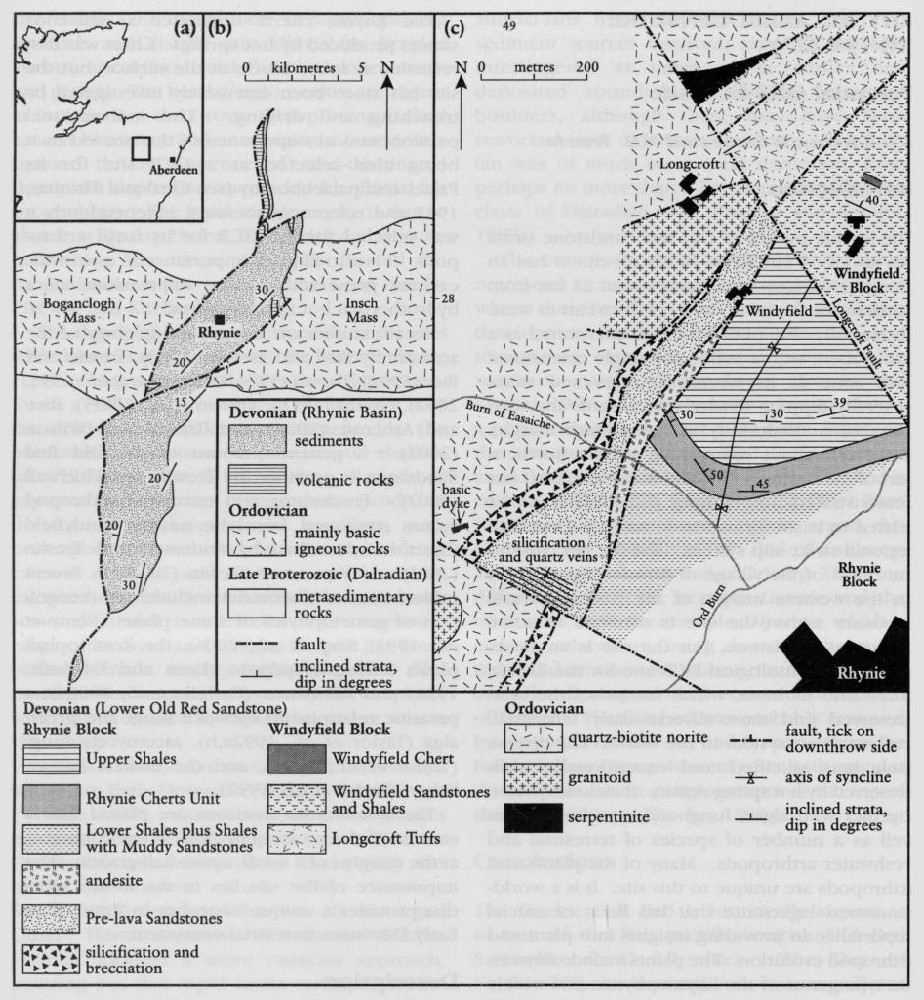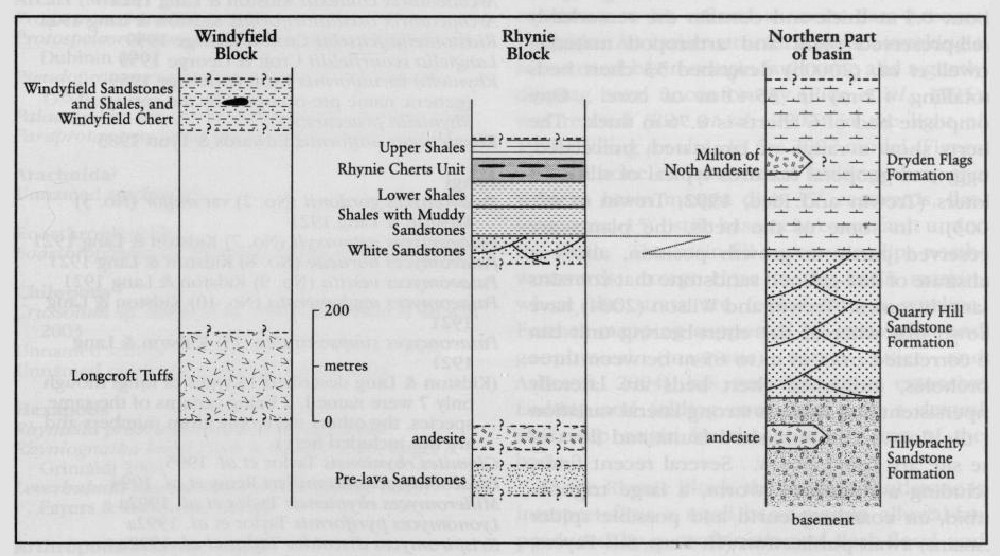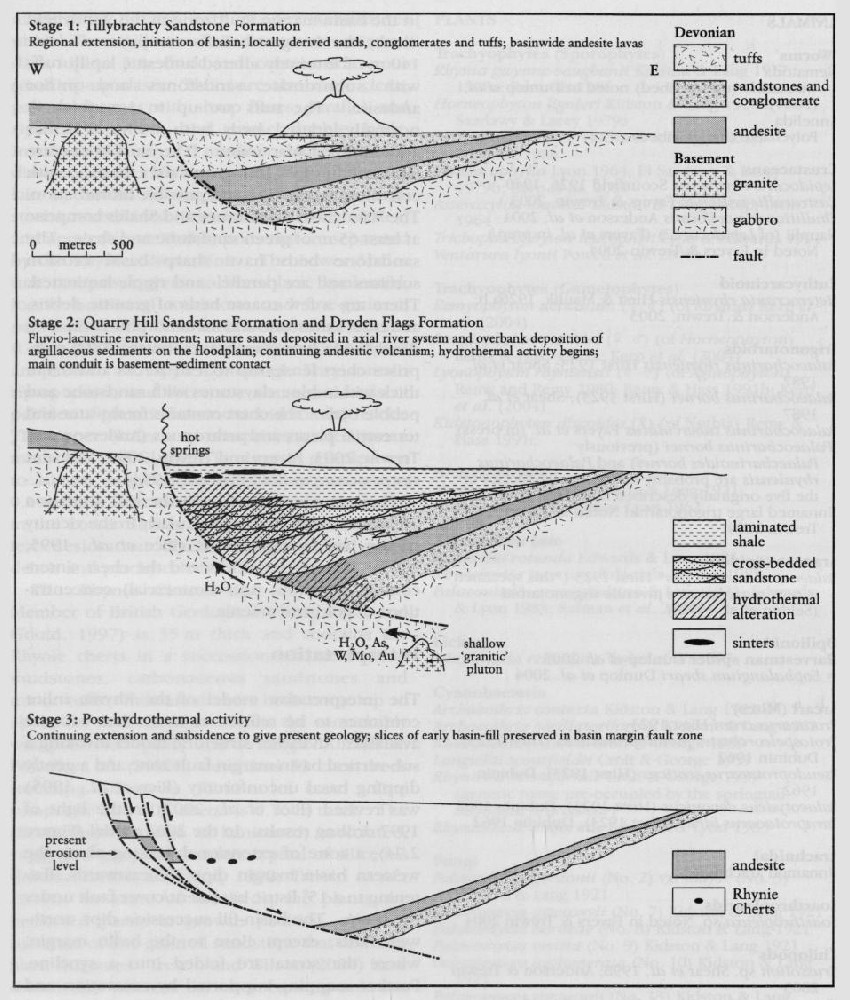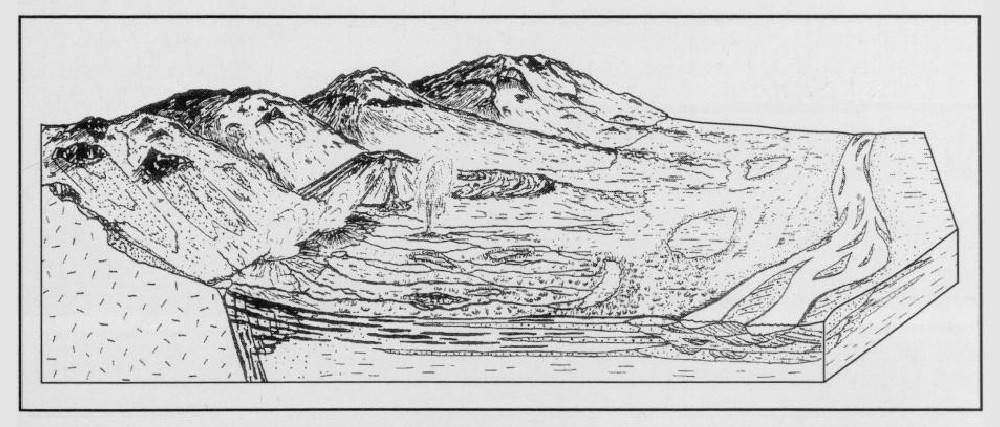Rhynie, Aberdeenshire
Potential ORS GCR site
W.J. Barclay, P. Stone and N.H. Trewin
Introduction
The Rhynie outlier of Old Red Sandstone strata lies about 50 km WNW of Aberdeen. It has an elongate outcrop measuring about 21 km from north to south and up to 3 km from east to west. Structurally, the inlier has been interpreted as a half-graben, with a major, low-angle extensional fault zone at its western margin and strata generally dipping moderately towards the west from an unconformity at the eastern margin. However, recent re-mapping of the northern part of the basin by Rice and Ashcroft (2004) has demonstrated that faulting and folding can be related to basin formation in an Early Devonian regional strike-slip system. The site lies close to the north of the village of Rhynie
The Rhynie cherts originated as siliceous sinters produced by hot springs. Chen was first recorded as loose blocks at the surface, but the site has since been extensively investigated by trenching and drilling. The international palaeobotanical importance of the site led to it being also selected as a GCR site for its Palaeozoic palaeobotany (see Cleal and Thomas, 1995 and references therein); independently it was selected for the GCR for its fossil arthropods. It is also of great importance as one of the earliest preserved surface expressions of a hydrothermal hot spring system.
Recent studies on the general geology of the area are by Rice and Trewin (1988), Trewin and Rice (1992), Trewin (1994, 1996), Rice et al. (1995, 2002), Gould (1997), Trewin et al. (2003), Rice and Ashcroft (2004) and Trewin and Wilson (2004). A general account of the Old Red Sandstone is provided by Trewin and Thirlwall (2002). Freshwater and terrestrial arthropod faunas recovered from the nearby Windyfield Chert are described by Anderson and Trewin (2003) and Fayers and Trewin (2004). Recent palaeobotanical discoveries include the recognition of gametophytes of some plants (Remy et al., 1993; Kerp et al., 2004), the Zosterophyll plants Trichopherophyton (Lyon and Edwards, 1991) and Ventarura (Powell et al., 2000a), a parasitic relationship between fungi and green alga (Taylor et al., 1992a,b), ascomycete fungi (Taylor et ed., 1999), and the earliest known lichen (Taylor et al., 1997).
The fossiliferous horizons are placed into a context of the evolving geological environments at the margins of a small, active half-graben. The importance of the site lies in the in-situ biota that provides a unique 'snapshot in time' of an Early Devonian terrestrial ecosystem.
Description
The GCR site spans an area of land adjacent to the road from Rhynie to Cabrach
In the Rhynie area the basement to the Old Red Sandstone succession consists mainly of basic igneous rocks (quartz-biotite norite and minor serpentinite) and some granitoids belonging to the Ordovician Boganclogh intrusion. These are separated by an extensional, basin-margin fault zone from the overlying Old Red Sandstone sedimentary and volcanic rocks. The basin-margin fault zones in the Rhynie and Windyfield blocks comprise faulted slices of the basin-fill, as yet uncorrelated between blocks, although Rice et al. (2002) estimate that the Longcroft Fault throws down to the north-east by about 160 m, with chert outcrops in the Windyfield Block lying at a higher level than the Rhynie cherts.
The basal part of the succession in the basin-margin fault zone in the Rhynie Block comprises 30 m of mostly lithic sandstone, pebbly sandstone and conglomerate
A faulted sliver of purple vesicular, andesitic lava separates the Pre-lava Sandstones from the overlying
The Rhynie Cherts Unit (
PLANTS
Trachyophytes (Sporophytes)
Rhynia gwynne-vaughanii Kidston & Lang 1917, 1920a; Edwards 1986
Horneophyton lignieri Kidston & Lang 1920a; El-Saadawy & Lacey 1979a
Aglaophyton major (Kidston & Lang 1920a); Edwards 1986
Nothia aphylla Lyon 1964; El Saadawy & Lacey 1979b; Kerp et al. 2001
Asteroxylon mackiei Kidston & Lang 1920b; Lyon 1964
Trichopherophyton teuchansii Lyon & Edwards 1991
Ventarura lyonii Powell et al. 2000a
Trachyophytes (Gametophytes)
Remyophyton delicatum (♀ ♂) (of Rhynia) Kerp et al. (2004)
Langiophyton mackiei (♀ ♂) (of Horneophyton)Remy & Hass 1991a; Kerp et al. (2004)
Lyonophyton rhyniensis (♀ ♂) (of Aglaophyton)Remy and Remy 1980; Remy & Hass 1991b; Kerp et al. (2004)
Kidstonophyton discoides (♀) (of Nothia) Remy & Hass 1991c
Nematophytes
Nematophyton taiti Kidston & Lang 1921
Nematoplexus rhyniensis Lyon 1962
Algae sensu lato
Mackiella rotunda Edwards & Lyon 1983
Rhynchertia punctata Edwards & Lyon 1983
Palaeonitella cranii Kidston & Lang 1921; Edwards & Lyon 1983; Kelman et al. 2004
Lichen
Winfrenatia reticulata Taylor et al. 1997
Cyanobacteria
Archaeothrix contexta Kidston & Lang 1921
Archaeothrix oscillatoriformis Kidston & Lang 1921
Kidstoniella fritschii Croft & George 1959
Langiella scourfteldii Croft & George 1959
Rhyniella vermiformis Croft & George 1959 (generic name pre-occupied by the springtail Rhyniella praecursor)
Rhynicoccus uniformis Edwards & Lyon 1983
Fungi
Palaeomyces gordonii (No. 2) var major (No. 3) Kidston & Lang 1921
Palaeomyces asteroxyli (No. 7) Kidston & Lang 1921
Palaeomyces horneae (No. 8) Kidston & Lang 1921
Palaeomyces vestita (No. 9) Kidston & Lang 1921
Palaeomyces agglomerata (No. 10) Kidston & Lang 1921
Palaeomyces simpsonii (No. 13) Kidston & Lang 1921
(Kidston & Lang described 15 types of fungi though only 7 were named, 2 being variants of the same species, the others were only given numbers and are not included here)
Glomites rhyniensis Taylor et al. 1995
Palaeoblastocladia milleri Remy et al. 1994
Milleromyces rhyniensis Taylor et al. 1992a
Lyonomyces pyriformis Taylor et al. 1992a
Krispiromyces discoides Taylor et al. 1992a
Ascomycetes Taylor et al. 1999
ANIMALS
'Worms'
Nematoda
Nematode (undescribed) noted in Dunlop et al. (2004)
Annelida
Polychaete (undescribed)
Crustaceans
Lepidocaris rhyniensis Scourfield 1926, 1940
Castracollis wilsonae Fayers & Trewin, 2003
Ebullitiocaris oviformis Anderson et al. 2004
Nauplii (of Lepidocaris?)(Fayers et al. in prep.) Noted in Fayers & Trewin 2004
Euthycarcinoid
Heterocrania rhyniensis Hirst & Maulik, 1926a,b;
Anderson & Trewin, 2003
Trigonotarbids
Palaeocharinus rhyniensis Hirst 1923; Shear et al. 1987
Palaeocharinus hornet (Hirst 1923); Shear et al. 1987
Palaeocharinus tuberculatus Fayers et al. (in press)
(Palaeocharinus hornet (previously Palaecharinoides hornet)and Palaeocharinus rhyniensis are probably the only valid species of the five originally described by Hirst)
Unnamed large trigonotarbid Noted in Fayers & Trewin 2004
Araneae (Spiders)
Palaeocteniza crassipes* Hirst 1923 (*this specimen is now regarded as a juvenile trigonotarbid (Selden et al. 1991))
Opilionids
Harvestman spider Dunlop et al. 2003
= Eophalangium sheari Dunlop et al. 2004
Arcari (Mites)
Protacarus crani Hirst 1923
Protospeleorchestes pseudoprotacarus (Hirst 1923); Dubinin 1962
Pseudoprotacarus scoticus (Hirst 1923); Dubinin 1962
Palaeotydeus devonicus (Hirst 1923); Dubinin 1962
Paraprotacarus hirsti (Hirst 1923); Dubinin 1962
Arachnida?
Unnamed arachnid(?)
Eoarthropleurids
Eoarthropleura sp. Noted in Fayers & Trewin 2004
Chilopods
Crussolum sp. Shear et al. 1998; Anderson & Trewin 2003
Unnamed scutigeromorph Fayers & Trewin 2004
Unnamed centipede Fayers & Trewin 2004
Hexapods
Rhyniella praecursor Hirst & Maulik 1926
Rhyniognatba hirsti Hirst & Maulik 1926; Engel & Grimaldi 2004
Leverhulmia mariae Anderson & Trewin 2003; Fayers & Trewin (in press)
Arthropoda incertae sedis
Rhynimonstrum dunlopi Anderson & Trewin 2003
In the basin-margin fault zone of the Windyfield Block, the Longcroft Tuffs comprises at least 140 m of intensely altered andesitic lapilli tuffs with subordinate sandstones and minor andesite. The tuffs are up to 1 m thick in normally graded beds with lithic, vesicular and non-vesicular clasts. The sandstones are laminated, in fining-upward beds, with convolute lamination and possible bioturbation. The Windyfield Sandstones and Shales comprise at least 65 m of green sandstone and shale. The sandstone beds have sharp basal erosion surfaces and are parallel- and ripple-laminated. There are a few coarse beds of granitic debris, andesite, sandstone and metamorphic rock. The Windyfield Chert (Fayers and Trewin, 2004) comprises chert lenses up to 1 m across and 0.3 m thick within blue claystones with sandstone and pebble beds. The chert contains freshwater and terrestrial plants and arthropods (Anderson and Trewin, 2003; Fayers and Trewin, 2004) and vent sinter occurs as float (Trewin, 1994).
There is widespread hydrothermal alteration of the Devonian rocks, particularly in the vicinity of the basin-margin faults (Rice et al., 1995, 2002). The altered rocks and the chert sinters contain high (but non-commercial) concentrations of gold and arsenic.
Interpretation
The interpretative model of the Rhynie inlier continues to be refined as more data become available. An earlier structural model invoking a sub-vertical basin-margin fault zone and a gently dipping basal unconformity (Rice et al., 1995) was revised (Rice et al., 2002) in the light of 1997 drilling results. In the 2002 model
In the Rhynie Block, the Pre-lava Sandstone is interpreted as a small basin-margin alluvial-fan produced by a combination of flash-flood and channel deposition (Trewin and Rice, 1992; Rice et al., 2002). The rare calcrete nodules indicate soil formation in a subaerial, seasonally wet environment and semi-arid climate. The clastic rocks are derived from the local igneous basement and there is no evidence for volcanicity prior to the eruption of the overlying andesitic lava flow. The White Sandstones are interpreted as the deposits of shallow, fluvial channels and sheet-flood events. The Shales with Muddy Sandstones, Lower Shales and Upper Shales are predominantly lacustrine and floodplain deposits. Trewin and Rice (1992) and Rice et al. (1995, 2002) interpreted the depositional environment as ephemeral, shallow lakes on an alluvial plain that periodically dried to desiccated mudflats. The fine lamination of the mudstones is attributed to minor seasonal changes in sediment supply, the thin, rippled sandstones representing clastic input to the lakes during flooding events. The tuffaceous sandstones at the base of the Shales with Muddy Sandstones (the Tuffaceous Sandstones of Trewin and Rice, 1992) are largely fine grained and quartzose, but also contain angular, vesicular andesitic clasts. Some of the more tuffaceous beds may be volcanic ashfall deposits, implying contemporaneous volcanicity, but most of the volcanic material was transported by water from a local source. Trewin and Rice (1992) placed these beds stratigraphically immediately above the andesitic lava, but the contact between the units is now interpreted as a fault (Rice et al., 2002). Archer (1978) and Trewin and Rice (1992) interpreted the beds as alluvial-plain deposits, with regional axial current flow from the south (Archer, 1978). Trewin and Rice suggested that a nearby tuff cone undergoing erosion provided the volcanic debris, and that the laminated shales were overbank deposits of small ephemeral pools. The rare calcrete nodules are evidence of carbonate soil formation in a climate that continued to be semiarid and seasonally wet.
The Rhynie Cherts Unit has received much attention on account of its plant-bearing cherts. For a historical summary see Cleal and Thomas (1995). Interpretations are given by Trewin and Rice (1992), Trewin (1994), Rice et al. (1995, 2002) and Trewin and Wilson (2004). The revised model (Rice et al., 2002) invokes silica deposition from mineral-rich hydrothermal fluids that emanated from hot (about 100°C) springs along basin-margin faults during the waning of local volcanism. Hot spring activity may have occurred at intervals along at least 2 km of the fault zone as pulses of fluid were released by subsidence movement along the fault zone. The silica-rich fluids permeated an alluvial plain with scattered small ponds, depositing surface sinter. Trewin and Wilson (2004) conclude that sinter deposition took place on a low-angle outwash apron from a hot spring, and that overbank flooding from a river system deposited the sand and mud interbeds
In the Windyfield Block, the Longcroft Tuffs are interpreted by Rice et al. (2002) as the product of volcanic activity from a nearby centre, producing lava and airfall tuffs, as well as the product of the erosion of the volcanic source. This introduced coarse debris during flood events into an otherwise low-energy fluvio-lacustrine floodplain. The Windyfield Chert was the product of hydrothermal silicification of the contents of freshwater pools in the vicinity of a hot spring vent.
Rice et al. (2002) suggest correlation of the strata in the Rhynie and Windyfield blocks with the succession recognized in the northern part of the Rhynie Basin
Conclusions
The GCR site at Rhynie is arguably the most important Old Red Sandstone site in Great Britain and one of the most important in the world. In addition to its status as a unique Early Devonian faunal and floral lagerstatte, it is also one of the earliest-known occurrences of the surface expression of a hydrothermal spring system. The strata include cherts that contain an exceptionally well-preserved, silicified, internationally important early land-plant and arthropod assemblage, the whole in-situ biota providing an insight into plant and arthropod evolution and the development of terrestrial ecosystems. The fossiliferous horizons are placed into a context of evolving geological environments at the margins of a small, subsiding basin. Initial alluvial-fan deposition was followed by the eruption of andesitic lavas, marking the local onset of volcanicity. Subsequent sedimentation was on an alluvial plain with ephemeral lakes and ponds. The climate throughout was semi-arid and seasonally wet. As volcanicity waned, the basin-margin faults acted as conduits for silica-rich, mineralized fluids. These emerged on the alluvial plain as hot springs and preserved the biota in siliceous sinters, now represented by the Rhynie and Windyfield cherts.




